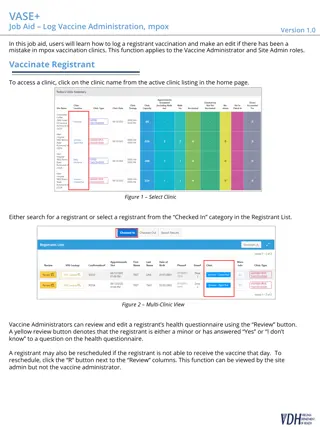Position Designation Tool (PDT) Job Aid for NIH - March/April 2020
The Position Designation Tool (PDT) is vital for determining background investigations accurately, maintained by the Defense Counterintelligence & Security Agency (DCSA). This tool identifies national security or public trust responsibilities for positions. Proper designation is crucial for federal government positions, ensuring suitability and security programs are effective and consistent. The PDT is designed to establish a dependable way of designating positions, aligning with federal regulations. All positions requiring logical or physical access to NIH must undergo background investigation designation through the PDT.
Download Presentation

Please find below an Image/Link to download the presentation.
The content on the website is provided AS IS for your information and personal use only. It may not be sold, licensed, or shared on other websites without obtaining consent from the author. Download presentation by click this link. If you encounter any issues during the download, it is possible that the publisher has removed the file from their server.
E N D
Presentation Transcript
Position Designation Tool (PDT) Job Aid for NIH March/April 2020 ORS Office of the Director | ors.od.nih.gov
OD PDT The Position Designation Tool (PDT) is the required method to determine the correct background investigation for a position. The tool is maintained by the Defense Counterintelligence & Security Agency (DCSA) in DOD. The PDT provides the ability to identify any national security or public trust responsibilities associated with a position. The link to access the PDT is https://pdt.nbis.mil/ DCSA PDT Training Course: https://www.dcsa.mil/mc/tec/upcoming_courses/ In the NED 5.2 release, a copy of the PDT must be uploaded to NED. Individuals responsible for designating positions are encouraged to attend formal PDT training offered by DCSA. AOs are encouraged to work with HR, supervisors, contracting officers, etc. to accurately complete the PDT. DPSAC in partnership with the NED Team will be offering training and job aids to the AO community. ORS Office of the Director | ors.od.nih.gov
OD Regulatory Guidance Per Parts 1400 and 731 of Title 5, Code of Federal Regulations, agencies are required to demonstrate adherence to the standards for proper designation of positions The PDT is designed to ensure a systematic, dependable, and uniform way of designating federal government positions Proper position designation is the foundation of an effective and consistent suitability and personnel security program and is in line with DPSACs mission to reduce the potential for abuse of public trust Parts 1400 and 731 of Title 5, Code of Federal Regulations establish the requirements for agencies to evaluate relevant covered positions for a position sensitivity and position risk designation commensurate with the duties and responsibilities of those positions. ORS Office of the Director | ors.od.nih.gov
What Positions require a PDT at NIH? ***Position Designation is not to be confused with Emergency Tier Designation*** All positions that require logical (account) and/or physical access to NIH that are subject to a background investigation must be designated using the PDT. For federal contractor/non-Federal positions, the designator must assess the duties the position will be performing on behalf of the Federal Government and not those performed on behalf of the contract employer. If the individual completing the PDT is not sure which selections within the PDT are applicable, they should contact the supervisor or project officer who will be providing oversight for the position.
Position Designation System Developing a familiarity and understanding of the underlying logic for the Position Designation tool, Position Designation System (PDS), is essential The success and consistency of the PDT are connected to the user's understanding of the various possible selections related to the national security and public trust requirements within the Position Designation System. It is recommended that individuals completing the PDT use the Position Designation System as a reference guide The PDS is accessible here: https://www.opm.gov/suitability/suitability-executive-agent/position-designation- tool/position-designation-system-with-glossary-2017.pdf 5
Position Designation Responsibilities Individuals completing the PDT must carefully evaluate the Position Description (or equivalent) and any other position information to: Assess the nature of the position as it relates to the potential material adverse impact to the national security, or public trust Determine the proper designation and required level of investigation Individuals who may be responsible for completing the PDT at NIH may include: NIH Office of Human Resources (for Federal Staff) Contract Officers Representatives, Project Officers or Administrative Officers (for non-Federal Staff) 6
Position Designation Steps Use of the PDT consists of a four-step process that guides the designator through an examination of the position s duties and responsibilities The completion of the PDT process will result in a final designation for the position which, in turn, will determine the investigative requirement for the position 7
Position Designation Steps Position Designation Process: Examine and select the National Security Requirements of the Position and determine the Potential Damage to the National Security 1. Examine and select the Public Trust Requirements of the Position (unrelated to National Security) and determine the potential impact on the efficiency or integrity of the service 2. 3. Apply adjustments for scope of program impact and level of supervision 4. Final Position Designation and Investigation Requirement As defined in 5 CFR 1400.102(a), national security refers to those activities which are directly concerned with the foreign relations of the United States, or protection of the Nation from internal subversion, foreign aggression, or terrorism.
Position Sensitivity & Risk Calculations Once all selections are made, the PDT will automatically calculate the Sensitivity and Risk Level of the position, and the corresponding Investigation requirement Sensitivity Level: Degree of potential material adverse effect on the national security from misconduct of an incumbent of a position Risk Level: Degree of potential damage to the efficiency or integrity of the service from misconduct of an incumbent of a position
Sensitivity & Risk Levels with Corresponding Degree of Damage Inestimable Damage to National Security (Harm to National Security too severe to be computed or measured) Special-Sensitive T5 To National Security (High Risk T5) Exceptionally Grave Damage to National Security (Extremely serious harm to the national security) Critical-Sensitive T5 Potential Damage (High Risk T5) Significant or Serious Damage to National Security (Noteworthy harm to the National Security) T3 or T5 Noncritical-Sensitive (High Risk T5 or Moderate Risk T3) Non-Sensitive Public Trust No material adverse affect on national security, potential for significant or serious damage to Public Trust T2 or T4 To Public Trust (High Risk T4 or Moderate Risk T2) No material adverse affect on national security and low risk of damage to Public Trust Non-Sensitive T1 (Low Risk T1) 10
Position Designation Final Output Proper position designation is required for: Accurate calculation and processing of background investigations and security clearance requirements Effective employee screening and suitability determinations Position Sensitivity & Risk Designation Chart Final Sensitivity Designation from PDT PDT Final Risk Designation from Type of Investigation Form Type Previous NIH PSL Designation PSL 4 Special-Sensitive or Critical- Sensitive High Risk Tier 5 SF 86 SSBI + TS/SCI (2% of NIH) Sensitive Positions Non-critical Sensitive "High Risk" Tier 5 SF 86 PSL 3 SSBI + TS ANACI "Moderate Risk" Tier 3 SF 86 PSL 2 Non-sensitive Public Trust "High Risk" Tier 4 SF 85P PSL 6 BI (98% of NIH) Non-Sensitive Positions "Moderate Risk" Tier 2 SF 85P PSL 5/5C PSL 1 MBI Non-sensitive "Low Risk" Tier 1 & T1C SF 85 NACI 11
DPSAC Responsibility Once the final Position Designation is made, DPSAC is responsible for: Ensuring the correct investigation is conducted based on the individuals calculated Position Designation Ensuringa suitability determination is made based on that investigation
OD PDT Landing Page You can access the PDT by visiting: https://pdt.nbis.mil/ [select Department of Health and Human Services/NIH] [enter supplemental duty here] [enter position title here] Can be more specific than what is listed in NED [optional: enter position description here] [enter series and grade for FTE; enter not applicable for non-FTE] [enter position description number for FTE; enter not applicable for non-FTE] [enter individual who completed the PDT who DPSAC can contact with questions] Fields are free text. Valid characters for all fields are: a-z, 0-9, spaces, and special characters: () " ' - _ . , ORS Office of the Director | ors.od.nih.gov
Step 1: Identify National Security Responsibilities Select all National Security factors that apply - OR - Select no factors apply ORS Office of the Director | ors.od.nih.gov
National Security Defined National Security Position: Any position in a department or agency, the occupant of which could bring about, by virtue of the nature of the position, a material adverse effect on the national security. As defined in 5 CFR 1400.102(a), national security refers to those activities which are directly concerned with the foreign relations of the United States, or protection of the Nation from internal subversion, foreign aggression, or terrorism.
Step 1a: Determine the Potential Damage to the National Security OD For any National Security factors selected, indicate the level of damage that may be caused by the position: Please contact the supervisor or project officer who will be overseeing the person filling the position if unsure of which selections to make. Select only one ORS Office of the Director | ors.od.nih.gov
Step 2: Identify Public Trust Responsibilities OD Select all public trust factors that apply - OR - Select no factors apply ORS Office of the Director | ors.od.nih.gov
Step 2a: Determine the potential impact on the efficiency or integrity of the service OD For any Public Trust factors selected, indicate the level of damage that may be caused by the position: Select only one ORS Office of the Director | ors.od.nih.gov
Step 3a: Point Adjustments for Scope of Impact for Damage OD Select the scope of impact for any damage that may be caused by the position If you are not sure which selections are applicable, please contact the supervisor or project officer who will be overseeing position Select only one ORS Office of the Director | ors.od.nih.gov
Step 3b: Point Adjustments for Level of Supervision OD For any factors that were selected in Section 2, indicate the level of supervision over the position If you are not sure which selections are applicable, please contact the supervisor or project officer who will be overseeing position Select only one ORS Office of the Director | ors.od.nih.gov
OD 4. PDT Final Designation Once complete, you will see the final position designation record. You can then save a copy of the record as a PDF file for uploading to NED. Use this to save the file for uploading to NED ORS Office of the Director | ors.od.nih.gov
NED & PDT Enter the PDT Tier Value into the NED system and upload the file: Instructions Select Tier Level Upload PDT file
DPSAC Responsibility Once the final Position Designation is made, DPSAC is responsible for: Ensuring the correct investigation is conducted based on the individuals calculated Position Designation Ensuringa suitability determination is made based on that investigation
Common Question May the true PDT results be modified if the agency is not in agreement with the results? For example, if a Division Director wants a Top Secret security clearance; however their final Position Designation is Tier 2 (non- sensitive moderate risk public trust) NO 26
OD PDT Resources For generic questions on the PDT, please contact the ORS Division of Personnel Security & Access Control at 301-402-9755 or ORSPersonnelSecurity@mail.nih.gov. If you have questions on how to properly designate a position, or would like assistance designating a position, please contact DCSA Suitability Adjudications at (724) 794-5612, extension 7400 or email SUITEA@opm.gov. DPSAC does not offer assistance completing the PDT. DCSA Position Designation training is highly recommended. Please view https://www.dcsa.mil/mc/tec/upcoming_courses/ for a list of available courses. To see a quick tutorial on the PDT, please visit: https://www.opm.gov/leaving/index.aspx?link=https://youtu.be/LCrT_ C_OIwg ORS Office of the Director | ors.od.nih.gov
Contact Information For general inquiries on the referenced materials, please visit the DPSAC website at https://www.ors.od.nih.gov/ser/dpsac/resources/Pages/investigation- requirements-for-your-position.aspx Contact: DPSAC Helpdesk: 301-402-9755 Email: ORSPersonnelSecurity@mail.nih.gov 28

















































